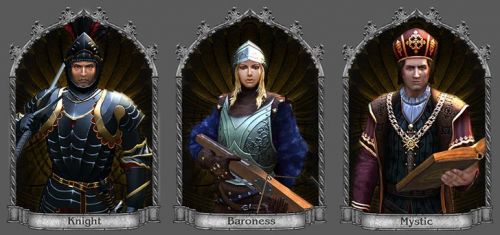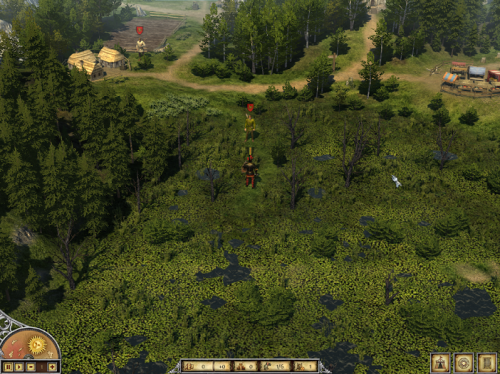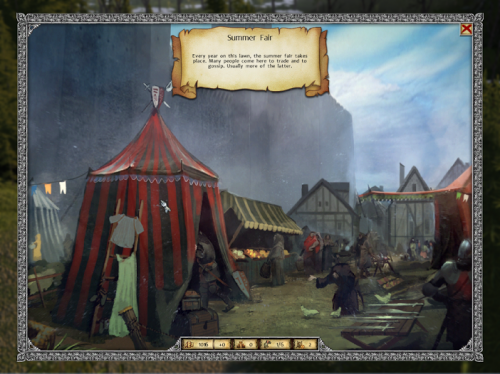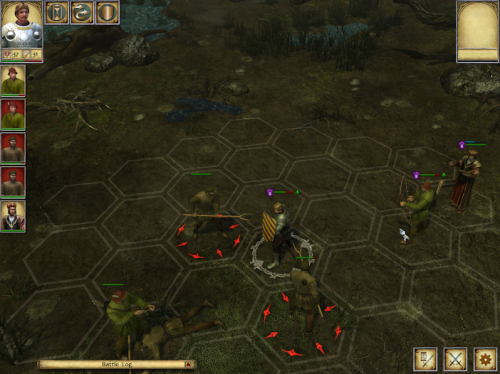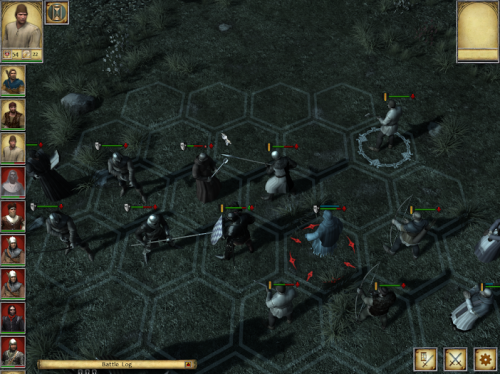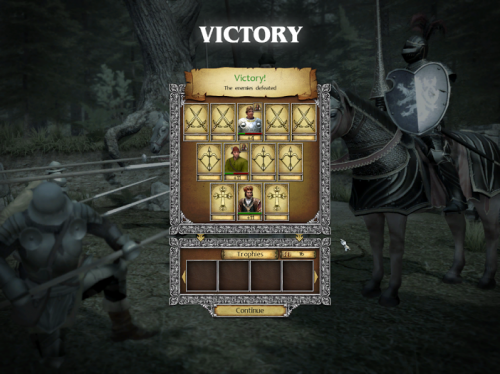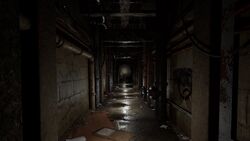RPG Codex Re-Preview: Legends of Eisenwald
RPG Codex Re-Preview: Legends of Eisenwald
Preview - posted by Infinitron on Tue 28 April 2015, 19:03:56
Tags: Alexander Dergay; Aterdux Entertainment; Legends of Eisenwald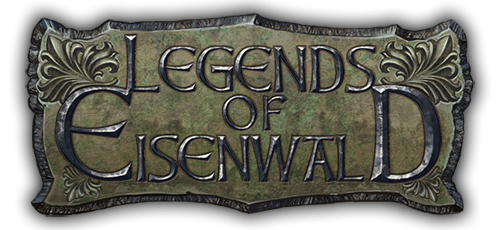
Legends of Eisenwald has been in development for some time, funded privately by Aterdux's staff as well as through a Kickstarter effort back in May of 2012. The Kickstarter pitch promised an RPG with tactical turn-based combat, strategy game aspects, a working economy, and a story that is driven more by human interactions than by invasions from mystical armies or demonic forces. And so, in this preview, I'll be judging the game on the merits of those promised features. The preview copy of Legends of Eisenwald that I received, being a beta version, was incomplete in places. Furthermore, it came with neither a manual nor any sort of verbose in-game help menu, so any struggles that I had with it might be attributed to my failure to understand its user interface. If this preview is wrong about anything with regards to said interface, I welcome others who have played the beta to step in and make the appropriate remarks, corrections, and belittlements.
You start your adventures in Eisenwald as the young scion of a powerful noble house adventuring abroad when news of disaster reaches you. Your family has been attacked and possibly wiped out, leaving you as the rightful ruler of your house's domain. In the ensuing chaos, your family's vassals have begun to war with one another and perpetuate crimes of varied severity against the civilian population, banditry has become commonplace resulting in the destruction of entire settlements, and an unknown force has decided to shack up in your family's stronghold. Right from the beginning of the game, you get a sense that the noble families of this world are constantly betraying one another in an attempt to come out on top. That feeling drives the narrative and keeps it down to earth, as the player and his family are affected by these machinations. No world-destroying demon or evil sorcerer-king in this game - just you and the inherent drama of trying to figure out who you can trust and where your enemy might strike next. The main quest will take you through eight scenarios, in which you will have to carefully choose your allies from a list of sordid characters, gather armies, and conquer enemy fortifications and villages, in order to uncover the mystery of the plot made against your family and ultimately take your revenge.
As you might expect, the first task the game expects of you is to choose your character. You can choose the Knight who is best at melee, the Baroness who is best at ranged combat, or the Mystic who can cast support spells in battle. This decision will determine what kind of army you will eventually want to build. For example, my Knight ended up being quite a force in melee combat, so I backed him up with just two more melee fighters and an archer or two, and having a healer in the back row was crucial. The Baroness has the potential to become very good at ranged combat, but you will want to ensure that you have a front line of troops sturdy enough to protect her and ensure that the enemy can't flank her while she goes to work. The Mystic will seem like the weakest choice at the beginning of the game, but he has a skill progression which may make him the strongest of the three later on. However, because of this initial weakness, when I played the Mystic, I had to rely on having a decent mixture of melee and support troops and just hope for the best. There are other small tweaks you can make during character creation, such as the selection of a name for your character and a family crest, but the class selection is the only part that truly matters. Once you've gotten past that, you are thrust into the campaign prologue, which acts as a tutorial, and then into the game proper.
Travel in the game is conducted via an overhead perspective, with a small figure of your character marking your current location. The figure moves where you mouse click, travelling over trails and through forests and villages at your whim. As you travel, time moves on and characters in the world go about their daily routines. By day they will travel. Merchants will go from village to village as if engaged in trade. Soldiers will move up and down roads from one fortification to the next, while staying inside the territory of their liege lord, giving the appearance that they are on patrol. At night, these same sorts of travellers will rest at a fortress, village or tavern. At any moment, should your character run into any of these individuals, you will enter a dialogue sequence with them, displayed as a portrait accompanied by dialogue options.
Entering structures on the world map will bring up a menu where you can make a wide variety of choices. For example, if you visit the local fair, you will be able to speak with any travelling characters who may have stopped in town or shop for accessories. Visiting a church or monastery will allow you to hire monks as mercenaries, pay for healing, or buy healing items for use in combat. Taverns are quite interesting, since they allow you to overhear rumors about what is going on in the surrounding land, and listen to tales which give you hints about the locations of people of importance or artifacts, which can lead to rewarding side quests if acted upon. Taverns also allow you to hire mercenaries in order to bolster your forces.
In addition to civilian structures, the world of Eisenwald also has fortifications. Entering fortifications you own allows you to place men inside to guard the territory from roving bandits or enemy soldiers. If an ally owns the fortification, you can talk to them or their followers if they are present. And if the fortification is owned by an enemy, you can choose to assault it in hopes of capturing it. There are big cities too, which can contain any number of the previous location types, so in a single city you might be able to talk to people, visit a church in order to get healing, buy and sell goods, etc. Finally, in addition to all of these, there are all sorts of special locations in the game as well, such as cemeteries where you can search for clues, destroyed or vacant villages where bandits might be hiding, and the occasional house with a quest-giving NPC. These miscellaneous locations give you an extra incentive to explore the world, in hopes of finding something of unique value or a new quest with decent rewards.
Shortly after the beginning of the game, you're joined by a strong melee fighter and an archer mercenary. Not long afterwards, your group is attacked by three mercenaries - two peasants and a bowman. This is the game's first combat encounter. Eisenwald's turn-based combat system is rather simple in execution. What tactical complexity exists comes from the diversity of skill sets your characters possess, with various strikes from your melee characters, various ammunition types from your bowmen and crossbowmen, buffing spells from your priests, offensive spells from your mystics, and healing spells from your healers. Characters lose hit points when they are struck, and fall when said hit points are reduced to zero. Fallen characters are not considered killed unless you lose the battle. Movement is hex-based, and initiative order is shown on a scrolling bar on the left-hand side of the screen.
That brings me to an aspect of the game that I had severe issues with - you can't move once you enter a hex that is adjacent to an enemy, unless you are willing to retreat a single hex and lose your turn. So if an enemy steps in front of my knight, the knight can't move backwards until said enemy is killed or the knight flees one hex. And if you encounter a warlock who can summon spirits, you are pretty much screwed. The summoned spirit is invulnerable to most weapons, and often even a character who is two hexes away will only be given the option to either lose a turn or waste an attack on it, when he should logically be able to go around it and attack the enemy's rear echelon. This is a very odd design choice that I do not agree with, as I feel that maneuver is a huge part of tactical games - I would expect to suffer attacks of opportunity when moving in melee, rather than have the option to move denied entirely. This limitation on movement is a particular large hindrance for the Knight character, since it limits the options available to him in melee to the following: strike the guy next to you, use your class skill to strike the guy next to you harder, or retreat back a hex and lose a turn. Compare that to the Baroness who can target any enemy within her line of sight, or the Mystic who has support spells that can aid any allies that are in his line of sight.
I will admit that this movement constraint made combat resolve faster, which may.have been the intent behind it. I asked Alexander Dergay (who is a true bro) about this and he replied with the following: "The restriction of movement is a conscious design choice. Allowing the free movement like in HoMM [Heroes of Might and Magic] would bring us back to the same combat system and will require to introduce points of movement. Also, since we aim for somewhat realistic medieval setting, this running around is very weird from this point of view - in a real fight people do not run around and archers are usually protected very well. And one more point to this - our main inspiration is Disciples 2 and we wanted to have combat that is not that grindy and long like in HoMM or King's Bounty yet still tactical. In a way, it's a hybrid of HoMM and Disciples 2 combats." As for my gripe about spirits, Alex explained that the team has realized that spirits are too tough for the beginning of the game due to the fact that your force lacks high level priests which could combat them and blessed weapons which could injure them, so they've removed them from the beginning of the game. It seems that Early Access playtesting has been helpful here.
Anyway, onward with the campaign. You will gather some loyal companions (who are given names), hire some mercenaries (who are not) and ride out to make your mark upon the world. You'll find yourself taking territory and trying to develop it to better finance your war, though the 'army' you control will never number more than 12 warriors (it's probably more appropriate to call it a large squad or small platoon). All of your characters will level up with enough experience, but only the player character can choose his or her own skills. Some of these skills can directly help on the battlefield, while others are useful in other ways, such as reducing daily expenditures or enabling troops to fight better. The NPCs, however, lack this range of options and must simply choose a professional path with predefined skills. This is a mark against the game in my opinion - many of these nameless men will be with you for a long time, but they're never given any personality. On the other hand, you can at least play dress up with everyone. All right, I'm teasing, but one nice feature of the game is that you can arm every one of your followers with different types of armor, weapons and accessories in order to enhance their combat abilities. Every soldier has slots for a helmet, shield and body armor, along with four slots for accessories which can enhance various attributes like damage or initiative, and two for utility items, which I normally used for healing items.
'Time is, time was, time is past'. Ok, I admit that I was just looking for an excuse to use that famous quote, but time is the most significant concern you will have in this game. You will need to muster as large a force as you can in order to take down your opponents, but mercenaries have both an initial cost and a daily upkeep which you must be able to meet. Acquiring territory will provide your character with additional daily revenue, but you will need to pay for better mercenaries as the game progresses to take on your increasingly challenging foes. No amount of daily revenue will truly be able to feed your army's increasing appetite. For example, at the beginning of the game, I was able to get by with a couple of pitchfork-wielding peasants and a monk as part of my front line. The monk was especially resilient and able to deal some righteous damage to my sinful enemies. However, just a few hours later, my peasants and monks were no longer adequate against the enemies I was facing, despite their having gone up a couple of levels during their tenure. I found myself considering whether to hire a single higher level noble swordsman to replace them, but his daily cost was close to the three peasants' combined, and I was worried that he would not be enough to hold my front line along with the pikeman I had been using.
Since the game's difficulty was constantly increasing, I was initially unsure whether the enemies were scaling to my character's level or whether they were truly becoming tougher over time. At one point, just when I felt ready to destroy the forces occupying my family's fortress, I suddenly found my men and resources decimated by a random encounter that came out from the west, making me wonder if all random encounters from that moment on were going to be that difficult. Once again, Alexander Dergay provided an excellent explanation: "We had first the idea of scaling the enemies to a player's strength but we decided against it. So, yes, we try to keep everyone interested with harder battles by design. I think you probably ran into one of the two raubritters in the Way Home chapter. So, the enemy forces are the same but since the world is alive and even enemies have their own tasks, they grow in experience, including their garrisons. I personally think scaling the enemies is almost cheating... when you run into a tougher opponent, maybe it's best to avoid him at the moment and take him later on. For us on our own it gets increasingly difficult to balance the game since knowing how it all works makes combat seem sometimes too easy for us. We rely these days on feedback of players and we added those harder encounters after quite a few players told us they needed more and stronger enemies. There is even an achievement for beating two of those raubritters." Props to Alex - I haven't gotten the opportunity to kill robber barons since Darklands. As you can see, though, time is your enemy in this game. You have to take on some of those side quests, but you can't ignore threats for too long while doing so, because your enemy is also on the move and getting stronger.
The economy remained an important factor throughout the game, driving me to attack bandits and take on increasingly greater challenges in order to acquire funds for paying the expensive daily costs of my mercenary force. Because of this, in my opinion the game's greatest challenge is actually at the operational level of war rather than at the tactical level. The coolest moment I had while playing was when, while trying to dislodge the enemy force that had occupied my family's estate, I realized that I could only afford to pay my army for two more days. However, I had a large number of side quests I had already agreed to take up, which could result in financial rewards. There were four noble families warring with one another with whom I could try to side with, and at the same time, a number of other quests from the locals who were being brutalized by those same noble families. I was unsure which vassals would turn out to be the most trustworthy in the long run, but I couldn't dally because of my financial situation, forcing me to make a decision about whether to betray one or two families in exchange for the support of the others, try to take back my home all by myself, or see if I could find a way to help all four families, make them remember their oaths to my family line, and compel them to drop their grievances against one another (as you can imagine, this last option turned out to not be possible). At that moment, I truly appreciated Legends of Eisenwald's potential, and my hope is that it can maintain that level of tension throughout the entirety of the final game.
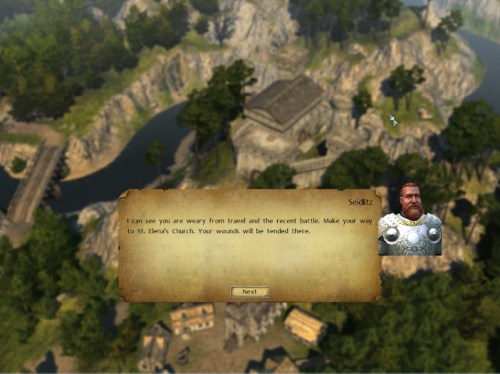
Get used to this man's mug. He looks exactly like several other NPCs you will run into in Eisenwald.
The optimal strategy in Eisenwald seems to be to focus your attention on your weaker enemies in order to build up enough funds to take on more difficult encounters while minimizing your losses. At the tactical level, you need to try to quickly take down the enemy's front line to disrupt his supporting units, and eliminate the enemy combatants faster than they can eliminate yours. Success comes from placing the larger, tougher force against the opposition, to quickly reduce the enemy's numbers on the battlefield and thus also his options per combat turn. This makes sense in any game of course, but it's even more important here, since healing is costly and you definitely want to save your funds to be able to afford more or better mercenaries. Note that you can't succeed at every quest given to you in this game, so it's always a good idea to check that you have the time before you act. The game has lots of choice and consequence, some of it via dialogue options, and some more opaque, like choosing what lead to track down first in a quest. Even the question of which noble vassals to support is ambiguous, as all of them are vicious bastards with a list of vices that would be worthy of a beatdown if it wasn't for the fact that you need help wherever you can get it.
Before we conclude, some technical bits. Considering this is an indie title, I'd say the graphics work well enough, although they are static and simplistic, lacking anything special that would make me pause to enjoy the scenery. The Aterdux website does mention that quite a bit of effort went into making the game's towers, fortresses, swords, armor, etc, as authentically medieval as possible, so there's that. The sound effects are typical, with swords and spears that make a satisfying crunching sound when striking armored opponents, and enemies who go 'argh' when reduced to their final hit point. The musical soundtrack is of a higher quality than both the graphics and sound effects, featuring authentic instruments and and also vocals, which sound like an attempt at a Loreena McKennitt impression. During combat the music ramps up to a faster pace, and I found that although I eventually got tired of the sound effects, the repeating combat tunes never became old.
In summary, Legends of Eisenwald promises to be an intriguing title. I have a few concerns with it, such as the lack of tactical maneuvering in melee, and the question of whether the designers can really balance economic and decision-making challenges over the course of a thirty hour game. However, there is a lot of good here as well, and I'd say there's a good chance Aterdux might have a real gem on their hands. We'll find out for sure when the game is released.
There are 58 comments on RPG Codex Re-Preview: Legends of Eisenwald






